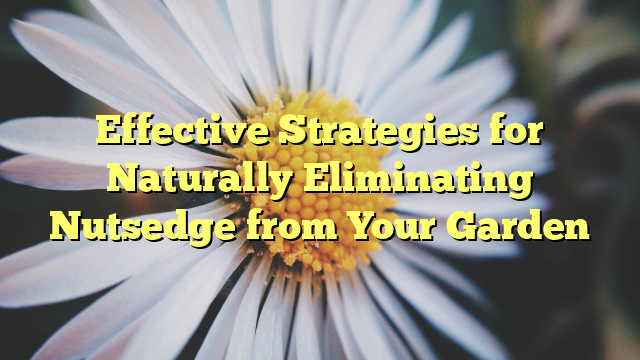Effective Strategies for Naturally Eliminating Nutsedge from Your Garden
Effective Strategies for Naturally Eliminating Nutsedge from Your Garden
Nutsedge, often mistaken for grass, is a persistent weed that can take over your garden if not controlled. Unlike other common weeds, nutsedge thrives in wet conditions and can be difficult to eliminate once it has established itself. However, with the right strategies, you can naturally remove nutsedge from your garden without resorting to harsh chemicals. This article explores effective, environmentally friendly methods to keep your garden nutsedge-free.
Understanding Nutsedge
Before diving into elimination strategies, it’s crucial to understand what makes nutsedge a challenging opponent. Nutsedge, also known as nutgrass, is not actually a grass but a sedge. It has a robust root system that includes tubers, making it resilient and hard to eradicate completely.
Types of Nutsedge
- Yellow Nutsedge: Characterized by its yellow-green leaves and golden brown flower spikes.
- Purple Nutsedge: This variety has darker leaves and purple flower spikes.
Why Nutsedge is a Problem
Nutsedge can quickly dominate a garden due to its fast growth rate and ability to spread. It competes with desirable plants for nutrients, water, and sunlight, often resulting in the stunted growth of your garden plants.
Natural Strategies for Eliminating Nutsedge
While nutsedge is tough, several natural strategies can help you control and eliminate it from your garden effectively.
1. Manual Removal
Manual removal is the most straightforward approach but requires patience and persistence. It involves pulling out the nutsedge plants by hand, ensuring you remove as much of the root system and tubers as possible. This method is most effective when the soil is moist, and the weed is young.
2. Solarization
Solarization uses the sun’s heat to kill nutsedge. During the hottest part of the year, cover the affected area with a clear plastic sheet for 4-6 weeks. The heat trapped under the plastic will kill the nutsedge plants and their tubers.
3. Improve Drainage
Since nutsedge thrives in wet conditions, improving drainage in your garden can help deter its growth. Consider adding organic matter to your soil or installing a drainage system to reduce standing water.
4. Mulching
Applying a thick layer of mulch can help suppress nutsedge growth by blocking sunlight. Use organic mulches like wood chips or straw, which also add nutrients to the soil as they decompose.
5. Use of Allelopathic Plants
Some plants naturally inhibit the growth of nutsedge by releasing chemicals that suppress it. Planting allelopathic plants like marigolds or sunflowers around your garden can help keep nutsedge at bay.
Preventative Measures
Prevention is key to ensuring that nutsedge does not become a recurring problem in your garden.
Regular Monitoring
Regularly inspect your garden for early signs of nutsedge. Early detection makes removal much easier and prevents the weed from spreading.
Maintain Healthy Soil
Healthy, well-aerated soil discourages nutsedge growth. Regularly add organic matter to your soil to improve its structure and fertility.
Proper Watering Practices
Avoid overwatering your garden, as nutsedge prefers moist conditions. Water your plants deeply but infrequently to encourage deep root growth and reduce surface moisture.
Conclusion
Eliminating nutsedge requires a combination of persistence, patience, and the right strategies. By understanding the nature of nutsedge and employing natural methods to combat it, you can keep your garden healthy and free of this invasive weed. Remember, the key to controlling nutsedge is not just in its removal but in taking preventative measures to ensure it doesn’t return.
| Strategy | Description | Effectiveness |
|---|---|---|
| Manual Removal | Pulling out plants by hand, ensuring root and tubers are removed. | High (when done early and thoroughly) |
| Solarization | Using the sun’s heat under clear plastic to kill nutsedge. | Medium to High |
| Improve Drainage | Adjusting soil conditions to reduce moisture. | Medium |
| Mulching | Applying a thick layer of organic mulch to suppress growth. | Medium |
| Allelopathic Plants | Planting certain plants that naturally inhibit nutsedge. | Variable |

